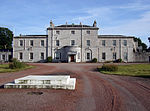Devil's Point, Plymouth
Geography of Plymouth, Devon

Devil's Point (also called Western King Point) is located on the eastern side of the mouth of the River Tamar where it meets the English Channel at Plymouth Sound.
Excerpt from the Wikipedia article Devil's Point, Plymouth (License: CC BY-SA 3.0, Authors, Images).Devil's Point, Plymouth
Admiralty Road, Plymouth Stonehouse
Geographical coordinates (GPS) Address Nearby Places Show on map
Geographical coordinates (GPS)
| Latitude | Longitude |
|---|---|
| N 50.3617 ° | E -4.1647 ° |
Address
Admiralty Road
PL1 3RS Plymouth, Stonehouse
England, United Kingdom
Open on Google Maps







